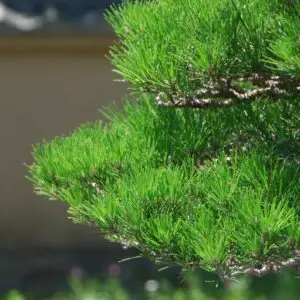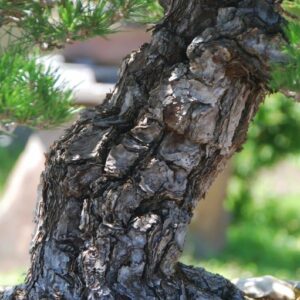Introduction to pine bonsai
Description
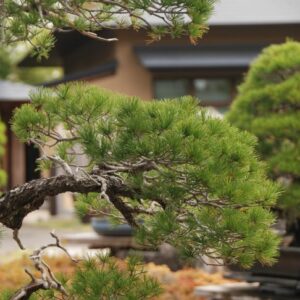
Pine trees are evergreen coniferous trees in the genus Pinus. They are one of the most popular bonsai species and are highly prized for their strong yet graceful beauty.
There are about 120 species (some consider about 180) in the genus Pinus growing mainly in the Northern Hemisphere, including North America, Europe and Asia. Of these, the following two species of pine are traditionally used for bonsai:
- Japanese black pine (Pinus thunbergii)
- Japanese white pine (Pinus parviflora)
Japanese red pine (Pinus densiflora) is also made into bonsai but is not as popular as Japanese black and white pines mainly because it tends to lose its most cherished charm, i.e. its red bark, when it is planted in a bonsai pot.
How long does it take to grow a pine bonsai from seeds?
Growing from seeds, it takes at least 5 years to make a mini pine bonsai and more than 10 years to make a full-size pine bonsai tree. It would take decades, if not centuries, if you want to make a fine, mature pine bonsai tree.
One of the reasons why it takes that much time is that Japanese black/white/red pine is slow-growing pine species whose growth rate is about 1/3 compared to fast-growing ones. This is good quality as a bonsai because maintaining its size and shape is much easier when growing slowly.
That said, this can be a major shortcoming when you decide to grow a pine bonsai from seeds. But making your own bonsai tree from scratch is such a pleasure that you wouldn’t want to trade it for anything.
Preparing the seeds
Choosing pine species
Among three traditional pine bonsai species, I believe Japanese black pine (Pinus thunbergii) or Japanese white pine (Pinus parviflora) is a good choice. Both have beautiful needles throughout the year and have attractive bark with slightly different textures. You can make a choice depending on your preference for looks.
One thing worth noting, though, is that the seed germination rate is said to be higher for Japanese black pine than Japanese white pine under the same conditions.
Needles
Japanese black pine needles are darker green compared to Japanese white pine needles which are light green.
Bark
Japanese black pine bark is dark grey and rougher with deep fissures compared to Japanese white pine bark which is pale grey and softer with shallow fissures.
For more about choosing pine species for a bonsai tree, please check the following post.
Where to get the seeds
Now that you chose which pine species to grow from seeds, you need to get the seeds from somewhere, and there are several options for this.
- Purchase from a local or online store
- Collect from trees nearby
- Ask friends or someone at a seed exchange
Purchase seeds from a store
There are a few things to consider when you decided to buy seeds from a store.
Reputation
Buying from a well-established or well-known store is very important because the seed germination rate depends, among others, on how seeds are stored and how old they are. Incorrect or inadequate storage will negatively influence the germination rate. Older seeds, in general, will not germinate as much as fresh ones.
Ask for recommendations from bonsai enthusiasts or look for online reviews to help find a good place to buy.
Price
Price is another factor to consider. I know a lower price seems better but it may be a sign of low quality. But a higher price does not necessarily guarantee high quality as well. It all comes down to the balance between the price and the trustworthiness of the store.
Seeds for bonsai
Lastly, it is important to choose seeds that are labeled for bonsai use. The pine seeds for garden use are often obtained from trees with thinner, flakey bark and straight trunks that grow tall.
Collect seeds from trees nearby
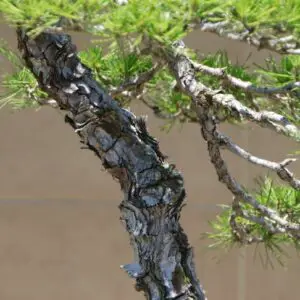
Which trees to collect from
Besides buying seeds from a store, you can collect them from pine trees nearby. But collecting seeds for bonsai does not mean that you can collect seeds from any pine tree. To be a good pine bonsai, a tree needs;
- To be able to grow small;
- Short and dense needles;
- Beautiful needle color (green and shiny); and,
- Thick, rough and scaly bark that does not come off easily.
Choosing a parent tree that has these characteristics is important. One thing you should know is that pine trees grown from seeds will not be true to the parent; they will be different from them and from each other because they inherit the genetic properties of both parents, bringing genetic diversity.
When and how to collect
The best time to harvest the pine seeds is around October when the cones mature and turn from yellowish green to slightly purplish brown. After the cones turn brown, their scales open up and the seeds in the cones fall off to the ground. Pick cones up from the parent tree before the scales open.
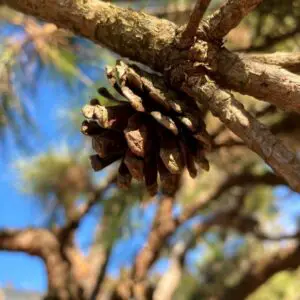
Pine cone in late fall (scales totally opened)
If you can, choose cones that bear on the sunny side of the tree since the cones in the shade include more seeds that do not germinate.
How to pick seeds from cones
Dry the cones taken from the tree under the sun until their scales open. Put them in a basket or bag and stir them with a stick or hand. The wings attached to the seeds fall off. You then get egg-shaped, yellowish-brown seeds 0.2 inches (4-5 mm) long. You can harvest 30 to 50 seeds per cone.
Dry the seeds under the sun for a day or two.
Seed selection
This is an optional step but if you want to select only good seeds, put them in water. Good seeds are those that sink within 5 hours, of which about 90% germinate.
Seed storage
Put the dried pine seeds in a can or jar and cover it without completely shutting oxygen out. Place it in a cool place. You do not need to store pine seeds in a fridge because their germination rate will not differ much whether you store them at room temperature or in the fridge.
How many seeds you need to start
You need 30 seeds to make 1-2 bonsai trees in 5 years from germination. The number of seeds you need to grow a bonsai tree depends on 3 factors;
- seed germination rate,
- seedling survival rate, and
- seedlings’ potential for growing into a good bonsai tree.
You may want to prepare double the amount, meaning 60 seeds, if you want to avoid any unexpected circumstances that lead to the total death of your baby bonsai.
For more about this topic, please check the following post.
Germinating the pine seeds
What you need for germination
To germinate pine seeds, you need;
- bonsai soil mix,
- seed tray or container, and
- a pot bottom net.
Bonsai soil mix
Recommended soil mix for the germination of pine seeds is;
-Akadama (small size): 70%
-Volcanic/river sand: 30%
(Link to Amazon)
The soil mix has to have good drainage as well as water retention.
Seeds do not need nutrients (compost or fertilizer) for germination. Avoid reusing bonsai soil mix that might include disease-causing fungi. Use a sterile soil mix that is free of weed seeds and diseases. You can buy ready-to-use soil mix from a store or make one at home.
If you want to make your own bonsai soil mix, check the following post. There is a step-by-step guide on how to make a homemade bonsai soil mix.
Seed tray/container
Containers are an important part of germinating pine seeds. When selecting containers, there are a few things to consider:
- Drainage
- Size
- Material
Drainage
It is very important to make sure that the container has good drainage because pine seedlings prefer dry soil and are very easily waterlogged.
Size
Choose a container that is big enough to accommodate the seedlings as they grow for a year. It does not have to be deep, though seedlings grow bigger/taller in deep containers.
Material
There are a variety of materials that can be used for containers. The growth rate would not differ much so consider price and handiness (weight/shape). Plastic seed trays are convenient, though not environmentally friendly.
How to germinate pine seeds
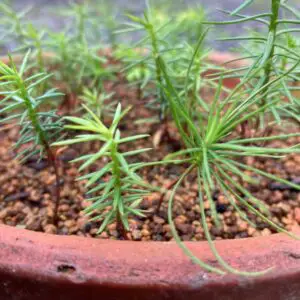
Right environment to germinate
Seeds need water, oxygen, proper temperature and light to germinate. Pine seeds require temperatures between 64°F and 77°F (18°C – 25°C) and 60-70% moisture to germinate.
Spring is the right season for sowing pine seeds.
Before sowing the seeds, soak them in water overnight. The stored seeds are quite dry (about 10% moisture level) and they would not germinate as much if sown dry. For faster and more uniform germination, keep the soaked seeds in a refrigerator at 32°F to 41°F (0°C to 5°C) for a week before sowing.
Sanitation is critical in the germination process. Disease-causing fungi can attack seedlings and kill them at an early stage. Make sure to use sterile soil and sanitized containers. You can wash the container to remove any old soil or debris before sowing.
A step-by-step guide to germinating pine seeds
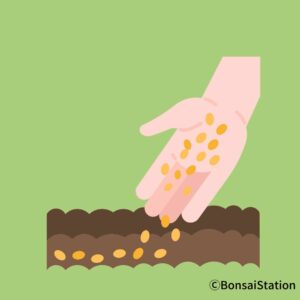
- Cover the drainage holes of the container with a pot bottom net.
- Put small gravel or pumice all over the bottom to improve drainage. Fill 90% of the container with soil mix.
- Drain water from the seeds that have been pre-soaked in water and scatter them evenly over the surface of the soil.
- Cover the seeds evenly with a fine layer of soil mix so that the seeds are hidden.
- Gently immerse the container in water from the bottom to let the soil absorb water completely.
- Put the container in a place with adequate airflow and 6-7 hours of sunlight every day.
- Water regularly so that the soil does not dry out completely.
- Take preventive measures if there is a risk of birds eating the seeds.
If the temperature, moisture and light are kept within the ranges required for germination stated above, the seeds will begin to germinate in about one to two weeks. The cotyledons (baby needles) will begin to open after three weeks.
Caring for pine bonsai seedlings
First year after gemination

Pine seedlings grow 2-3 buds in the first year and reach a height of about 0.4 inches (10 cm).
Thinning
Thin out the seedlings that do not grow well so that healthy ones can get sunlight and airflow evenly.
Placing
Pine trees are sun-loving plants. Put the seedlings in a place with a lot of sunshine as well as airflow.
Watering
Water the seedlings before the soil is completely dry. Keep in mind that pine trees prefer dry soil to moist one and that their roots are more susceptible to root rot than water-loving deciduous bonsai trees. Also, too much water will elongate the seedlings without thickening the trunk.
So, less water is usually better than more.
Fertilizing
Fertilize the seedlings with a very diluted liquid fertilizer (x2 the labeled dilution) once or twice in late summer.
Transplanting
Pine seedlings do not need to be transplanted in the first year after germination.
Second and third year after germination

Pine seedlings grow to a height of about 8-12 inches (20-30 cm) in two to three years.
Repotting
Pine seedlings are transplanted for the first time in the early spring of the second year.
To repot pine seedlings, you need;
- new bonsai soil mix,
- a pot bottom net,
- unglazed clay/terracotta pots for each seedling,
- bonsai scissors, and
- wooden chopsticks (optional).
Soil
The recommended soil mix for the second-year pine seedlings is as follows.
- Akadama: 70%
- River/lava rock: 30%
(Link to Amazon)
How to repot pine seedlings (2nd year)
- Make the soil mix. Put larger grain size soil in the bottom of the pot to improve drainage.
- Take time to pull the seedlings out of the container without damaging the roots. Use a wooden chopstick to loosen the soil if the roots do not come out easily.
- Remove 1/3 of the soil around the roots gently.
- Using bonsai scissors, cut off the roots that grow straight down and also cut other roots back to a radius of 1-2 inches (3-5 cm).
- Plant each seedling straight up in the new soil mix. Take time to spread the roots out evenly in all directions to make good surface roots.
Give plenty of water after repotting. Place the seedling in half shade for 2-3 days. Keep them out of the rain until it takes root.
How to repot pine seedlings (3rd year)
- Make the soil mix. Put larger grain size soil in the bottom of the pot to improve drainage. You can use the older pot or change the pot to a larger one if you want a bigger bonsai tree.
- Take time to pull the seedlings out of the soil without damaging the roots. Use a wooden chopstick to loosen the soil if the roots do not come out easily.
- Remove all the soil around the roots gently.
- Using bonsai scissors, cut the roots that grow straight down and also cut other roots back to a radius of 1.5-2.5 inches (4-6 cm).
- This time, do the first pruning. Prune the top of the trunk and cut off the stronger branches so that all the branches can grow evenly. The purpose of this is to lower the position of the branches and prevent the internodes from elongating.
- Plant each seedling straight up in the soil. Take time to spread the roots out evenly in all directions to make good surface roots.
Give plenty of water after repotting. Place the seedling in half shade for 2-3 days. Keep them out of the rain until it takes root.
After this third-year repotting, pine bonsai trees should be repotted every 3 to 4 years when young.
Fertilizing
Start fertilizing in the spring of the second year. Make sure not to overfertilize the pine seedlings when they are still small. With an abundance of nutrients, branches tend to elongate, the internodes to widen and the needles to lengthen, making the seedlings unsuitable for bonsai.
It is important to start with a diluted fertilizer and then very gradually increase the amount in the second and third year after germination.
Shaping
Change the direction of the pot from time to time so that the sun shines from all sides and seedlings grow evenly.
To encourage ramifications, pinch the new shoots by half when they have come out while the new needles have not yet opened.

pinching pine candle
(Source: Virginia State University)
Do not use wire for shaping during this period. The trunk will not thicken enough if seedlings are wired too early in the growth stage. Start wiring the trunk, if necessary, after they are 4 years old. Even at this time, just make a broad shape and do not bend the trunk strongly. Wiring of the branches starts in the fifth year.
For more detailed information about shaping bonsai seedlings, please check the following post.
Pest & diseases
After repotting, apply pesticides to prevent ticks and insects.
Around May, pine weevils may appear and cause great damage. Pine weevils are beetles that are considered to be the most destructive insect pest for pine trees. This insect can easily kill pine trees especially they are young.
Check the seedlings regularly for any signs of infestation. If they are in fact infested, prune the top part and other parts that look infested to destroy eggs and lava of this pest. Catch them with tweezers if you can. Using insecticide on top of this when necessary.
Common pine baby bonsai problems
Pine seedlings may have problems such as not growing enough, needles turning yellow/brown, needles dropping, wilting and dying. These are often caused by maltreatment such as too little sunlight, too much water, fertilizer burn, diseases or soil that do not drain well.
For more about this topic, please check the following post.


